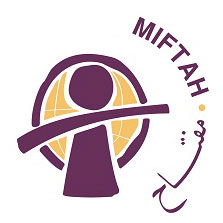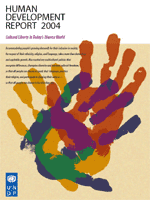The private sector is labeled as the engine of sustainable economic growth and development in the occupied Palestinian territory (oPt). The Palestinian Reform and Development Plan 2008-2010 calls for the private sector to generate productive employment, produce high value-added goods and services, and create the surplus needed to enhance national prosperity. However, evidence suggests that the private sector in the Gaza Strip finds itself in dire straits, and the obstacles it faces need to be removed, if it is to recover and carry out its role as the key actor stimulating growth.
UNDP/PAPP has commissioned a phone survey targeted at the business community in the Gaza Strip, which was conducted between 4 and 9 December 2007. Three hundred and nineteen businesses in the Gaza Strip were successfully surveyed. The results are staggering and indicate that the private sector in the Gaza Strip is on the verge of collapse with no scope for recovery unless the strict imposed closure regime on the Strip is lifted.
In the near future, UNDP/PAPP will release a full-fledged report on the private sector based on the information gathered. Meanwhile, some of the main findings merit immediate attention if action is to be taken in order to resuscitate the private sector in the Gaza Strip.
More than two years since the Israeli Disengagement from the Gaza Strip, political events have cast a shadow over the then anticipated economic boom. Prior to the January 2006 PLC elections, businesses in the Gaza Strip still functioned at 76% of their production capacity. From January 2006 to June 2007, the production level fell to 46%. Since the political events last June, the closure regime became even tighter, resulting in a further drastic drop in productivity to an average of 11%.
To View the Full Report as PDF (45 KB)
Israel’s Reproductive Genocide in the Gaza Strip
Date posted: April 29, 2025
By MIFTAH
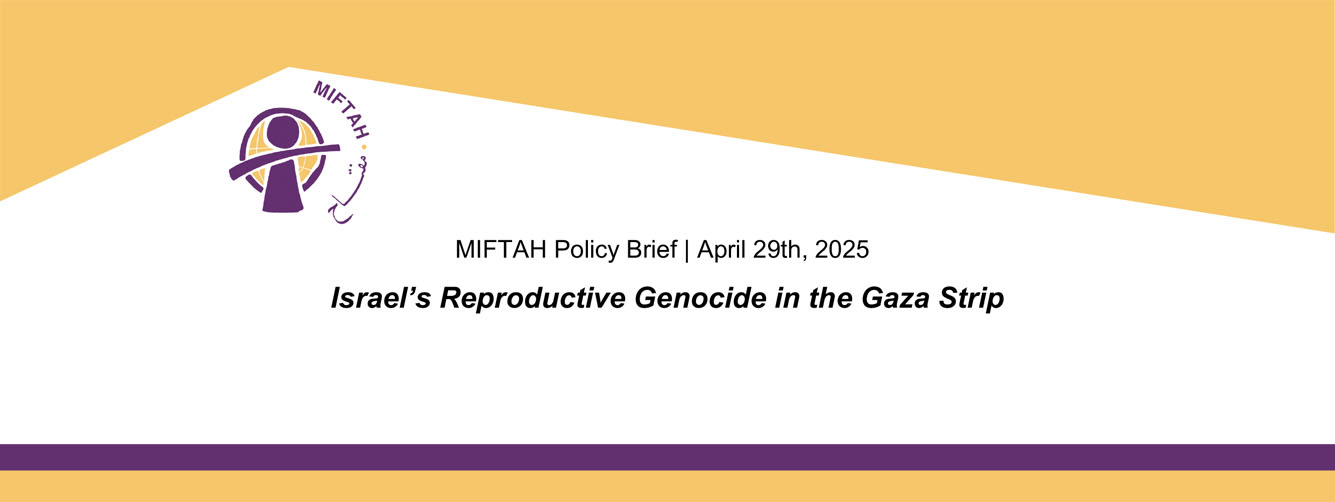
Executive Summary
The ongoing genocide in the Gaza Strip has compounded several humanitarian and legal violations, particularly inrelation to the reproductive rights of Palestinian women. Since the launch of its military offensive in October 2023, Israelhas systematically targeted Palestinian women in ways that undermine their ability to survive, give birth, and raisechildren. More than 12,300 women have been killed, 4,700 women and children are missing, and approximately 800,000women have been forcibly displaced. An estimated one million women and girls now suffer from acute food insecurity.Israel’s actions constitute a deliberate attempt to impair the reproductive capacities of Palestinian women, aimed atdismantling the future of Palestinian society. Through the bombing of shelters, destruction of hospitals, blockading ofmedical and hygiene supplies, and attacks on fertility clinics and maternity wards, Israel’s policy of erasure is notincidental, it is intentional.
To view the Full Policy Paper as PDF
Israel’s Attack on UNRWA and Its Implications for Palestinian Refugees
Date posted: March 05, 2025
By MIFTAH
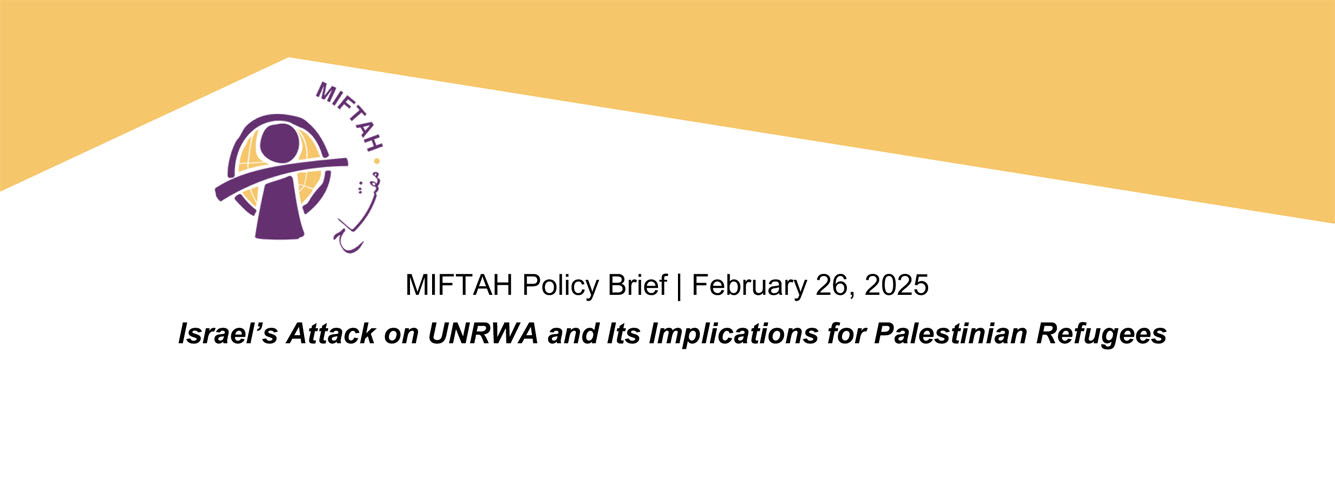
Executive Summary
The United Nations Relief and Works Agency for Palestine Refugees in the Near East (UNRWA) is vital inproviding humanitarian aid, education, and health services to Palestinian refugees across Jordan, Lebanon,Syria, and the Occupied Palestinian Territories. Beyond its humanitarian role, UNRWA represents aninternational commitment to Palestinian refugees' right of return, as established in UN General AssemblyResolution 194 in 1948. However, Israel has long sought to undermine the agency through financial, political,and military means.Recent Israeli actions have escalated, with the Israeli Knesset passing legislation banning UNRWAoperations in areas under Israeli control, effectively revoking its legal status. Concurrently, Israel hasintensified military attacks on UNRWA facilities. In the Gaza Strip since October 2023, Israeli forces havetargeted 310 UNRWA sites, destroying schools and killing 273 UNRWA employees alongside hundreds ofcivilians sheltering in its facilities. Throughout the occupied West Bank, the Israeli military has been turningUNRWA facilities into military bases and detention centers, and has closed UNRWA’s headquarters in EastJerusalem. These actions violate multiple international legal agreements and aim to erase Palestinian refugeeidentity and their legal rights.
To view the Full Policy Paper as PDF
Palestinian Women: The Disproportionate Impact of The Israeli Occupation
Date posted: November 21, 2018
By KARAMA
The shocking human cost that occupation has taken on Palestinian women is laid bare in research published today. Combining research, extensive surveys, and first-hand testimonies from over 40 Palestinian women, Palestinian Women: The Disproportionate Impact of The Israeli Occupation provides new insight into the gendered experience of occupation, looking into four issues in particular:
- women refugees
- the impact of residency revocation on Palestinian women in Jerusalem
- the experience of women prisoners
- Gazans’ access to health
Co-authored by four Palestinian NGOs – the Palestinian Initiative for the Promotion of Global Dialogue and Democracy (MIFTAH), Palestinian Working Woman Society for Development (PWWSD), the Women’s Centre for Legal Aid and Counselling (WCLAC), and Women Media and Development (TAM), the report includes detailed findings that demonstrate how the oppression occupation has permeated women’s daily lives, and the particular impact is has had on women in Palestinian refugee camps, Palestinian women living in Jerusalem, women prisoners, and residents of Gaza who require health services.
The impact on refugee women
Researchers spoke to 500 Palestinian refugee women from 12 Palestinian camps (7 in the West Bank, 5 in Gaza). Their findings included the following:
- A third of women surveyed had been directly exposed to physical assault by Israeli Occupation Forces. 9% had been exposed to threats of being attacked by police dogs during Israeli night raids on their homes.
- Over a third (37%) of respondents had been exposed to detention or interrogation, while 38% said that they or members of their households had been exposed to verbal abuse during Israeli army raids, at checkpoints or while visiting religious places.
- Nearly a quarter (24%) were forced to live in shelters or with extended family. 22% were forced to live under unhealthy conditions. 13% stated that the female and male members of their families were separated as a result of having to live in shelters.
- More than one in five (21%) had been exposed to beatings or tear gas at Israeli checkpoints while they were pregnant. 4% reported that they aborted or gave birth at Israeli checkpoints.
- The majority (64%- 321 cases) had been unable to visit religious or recreational places because of Occupation restrictions.
Jerusalem: Residency Revocation and Family Reunification
According to official figures, 14,595 Palestinians from East Jerusalem had their residency status revoked between 1967 and the end of 2016.
Through residency revocations, Israel has separated husbands from wives, parents from children, and extended families from one another, causing traumatic complications for women attempting to remain with their families in both Jerusalem and the West Bank.
This leads to traumatic fears of separation from children for mothers and an entrenching of patriarchal practices across society. Palestinian women living in Jerusalem lose residency rights if they get divorced or their husbands remarry. Limiting their access to justice, female victims of domestic violence fear reporting abuse to authorities in case they are forcibly transferred away from their children.
Women prisoners
Since the beginning of the Israeli Occupation of Palestine in 1967, approximately 10,000 Palestinian women have been arrested and detained by Israeli military forces. According to the Commission of Detainees and Ex-Detainees Affairs’ 2017 annual report, 1,467 children were arrested last year.
Our researchers spoke to prisoners who experienced physical and psychological torture at arrest and imprisonment, and traumatic, gendered treatment, including:
- Women denied access to menstrual products while detained
- A woman arrested while pregnant who gave birth while chained to a prison hospital bed
- Ex-prisoners who report being subjected to rape and death threats during interrogation, including a girl in of 15-years old threatened with rape
- Women who were subjected to frequent forced and violent strip searches
- A prisoner who reported toothache, only to have the wrong tooth removed
Access to Health in Gaza
Israel exercises strict control Gaza’s borders, a policy of ‘actual authority’, constituting continued occupation, despite the withdrawal of its permanent presence. This control in particular affects those who need medical treatment outside of Gaza’s struggling health system, who require permission to leave. The report shows that the rate of approval applications is falling year-by-year:
- 92.5% of applications were successful in 2012
- 88.7% in 2013
- 82.4% in 2014
- 77.5% in 2015
- 62.1% in 2016
Of the 26,282 permit applications submitted by patients aiming to exit through Erez in 2016, 8,242 (31.4%) were delayed. Many applicants received no response from border authorities, even after lawyers filed formal applications on their behalf. These delays regularly extend months and years beyond medical appointments, worsening already life-threatening diseases and in some cases resulting in death.
Read the full report here, or download it here:
Palestinian Women – The Disproportionate Impact of the Israeli Occupation
Women are Making Gains, but Still not Realizing Full Potential in Contributing to Prosperity and Strength of Arab States, Says New
Date posted: December 11, 2006
By UNDP
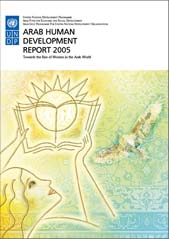
Arab Human Development Report
Report cites partial progress toward gender equality, calls for wider and deeper change
SANA’A, YEMEN, 7 December—Women in the Arab world are not realizing their full potential and are still denied equality of opportunity, says the Arab Human Development Report 2005: Toward the rise of women in the Arab world, arguing that this represents not just a problem for women, but a barrier to progress and prosperity in Arab societies as a whole.
The Report (selected parts of which are available online at http://rbas.undp.org/ahdr2005.shtml) commends some Arab states for “significant, progressive changes” in addressing the fundamental gender biases prevalent in the region. Yet the authors cite a range of obstacles to equitable development, from cosmetic reforms with little real effect to violent conflict, foreign occupations and terrorism, which cast a shadow over the tantalizing hints of progress glimpsed in the Report’s pages.
In 2002, the first Arab Human Development Report identified women’s disempowerment as one of three critical deficits crippling Arab nations in their quest to return to the first rank of world leaders of commerce, learning and culture. Now, four years later, the unequivocal necessity of securing for Arab women a fair chance to thrive has reached primacy as a precondition for development.
“Human development requires more than economic growth alone. The fight against poverty is not a campaign of charity - it is a mission of empowerment. This is especially true as regards women, given that, of the world’s one billion poorest people, three-fifths are women and girls. Full participation and empowerment of women, as citizens, as producers, as mothers and sisters, will be a source of strength for Arab Nations and will allow the Arab World to reach greater prosperity, greater influence and higher levels of human development,” said United Nations Development Programme (UNDP) Administrator Kemal Dervis. UNDP sponsored the Report.
This final report in the four-part series examines the situation of women in the region, with a special emphasis on health, education, and political participation. The 2005 Report also assesses the advancement of women by analysing Arab society’s desire for such progress, and the kinds of social action that are needed to achieve the goal of gender equality in the Arab states.
“To embrace the courage and activism of women in the Arab world is to champion the catalysts of human development. Hard-won gains in women’s rights are the culmination of decades of committed engagement by generations of women’s rights campaigners and their allies in Governments across the region,” said Amat Al Alim Alsoswa, UN Assistant Secretary-General and Director of UNDP’s Regional Bureau for Arab States.
The Report asserts that despite Arab women’s equal status under international law, their demonstrated talents and achievements in different spheres of human activity, and their priceless contributions to their families and society, many are not encouraged to develop and use their capabilities on an equal footing with men. In public life, cultural, legal, social, economic and political factors impede women’s equal access to education, health, job opportunities, citizens’ rights and representation, the Report contends. In private life, the Report says, traditional patterns of upbringing and discriminatory family and personal-status laws perpetuate inequality and subordination.
At the level of culture, the Report maintains, the fundamental obstacle to the rise of women remains how to deal with certain conflicts between the requirement of a productive economy and internationally agreed standards on the one hand and traditions and customs on the other.
The Report contends that the strongest inhibitors of development for many Arab citizens, women and men, have been foreign occupations and the ‘war on terror.’ “Women have endured a double portion of suffering under foreign occupation,” the Report says, and in many cases, the basic rights and freedoms of Arab citizens, extending from the right to life through civil and political rights to economic and social rights, have continued to be violated.
This negative environment—in conjunction with the spectre of extremist terrorism, which the Report condemns in the strongest possible terms—damages the prospects for a broad revival in the Arab world by impeding reform and obstructing opportunities for peaceful and just solutions to the occupation of Arab lands and the restriction of Arab freedoms and rights. A continued impasse over these matters, the Report argues, may push the region further towards extremism and violent protest in the absence of a fair system of governance at the global level that ensures security and prosperity for all.
However, the Report affirms, some achievements have been secured; most Arab countries now have a parliament, a cabinet or a local council in whose assigned tasks at least one woman participates effectively. Still, the Report warns that political reform, at every level, must go beyond the cosmetic and the symbolic: “In all cases…real decisions in the Arab world are, at all levels, in the hands of men.”
Islamic movements, often characterized in the West as uniformly malevolent forces, have, the Report contends, in reality been in many cases at the vanguard of women’s empowerment. “In the last five decades, the internal dynamics of these movements, their relationship to mainstream society and their positions on vital societal issues, on human rights and on good governance and democracy have undergone significant, progressive changes,” the Report explains.
Most of the mainstream Islamic movements, according to the AHDR, are witnessing notable growth of an enlightened leadership among their relatively younger generations. In addition, there is a growing grass-roots mandate for greater internal democracy, the Report says. However, these positive developments have not canceled out other currents outside mainstream Arab society that could seek to curtail freedom and democracy if they came to power, especially with regard to women.
Another reason for optimism can be found in the results of the public-opinion polls commissioned for the Report. The polls reveal a broad desire for a level of gender equality higher than that found today, and certainly higher that that which will result if societal obstacles to the rise of Arab women remain in place.
The Report affirms that a transformation is taking place in the Arab world, as women’s issues are increasingly permeating intellectual and cultural discourse: “Contemporary media forms such as the Internet, chat rooms, satellite television channels and their specialised programmes are based on the power of open public dialogue, quick communication and accessible communities of thought and practice. For women, they open up a new avenue of liberation that allows them to occupy spaces that they could not have entered through the conventional print media.”
Still, the modern Arab women’s movement is too often misconstrued as an import from the West; in reality, the concept of gender equality has deep roots in the region. Egypt’s first “women’s educational society” was founded in 1881, with raising public awareness of women’s rights as a key objective. The 1940s, under colonialism, saw a surge in women’s organizations, most of which dedicated themselves to issues like polygamy and women’s right to education.
The Arab Human Development Report 2005 concludes that the rise of women in the Arab world requires, first, that all Arab women be afforded full opportunities to acquire essential health, and knowledge on an equal footing with male counterparts. Second, “full opportunities must be given to Arab women to participate as they see fit in all types of human activity outside the family on an equal footing with men.”
In line with the calls in previous reports for comprehensive, rights-based societal reforms, the AHDR asserts that the rise of Arab women entails:
- Total respect for the rights of citizenship of all Arab women.
- The protection of women’s rights in the area of personal affairs and family relations.
- Guarantees of total respect for women’s personal rights and freedoms.
In addition, the Report calls for the temporary adoption of affirmative action in expanding the participation of Arab women to all fields of human activity. This will allow the dismantling of the centuries-old structures of discrimination against women.
The Report maintains that the rise of women requires a wide and effective movement in Arab civil society aimed at achieving human development for all. Such a movement, the Report asserts, will be the means by which Arab women may empower themselves and their male supporters. It will have two levels. The first is national and will involve all levels of society in every country. The second is regional and will be founded on trans-border networks for co-ordination and support of regional efforts to empower women.
* * *
For more AHDR information please visit www.undp.org/arabstates
For further information, please contact:
New York: Sausan Ghosheh, Tel. +1 (212) 906-5390 or Cell +1 (917) 213 0671, sausan.ghosheh@undp.org; Benjamin Craft, Tel. +1 (212) 906-5344 or 1 (212) 906-5382, E-mail: benjamin.craft@undp.org
Geneva and Paris: Jean Fabre, Tel. + 41 22 917 8542 or Cell + 41 79 437 0776, E-mail: jean.fabre@undp.org
London: Chandrika Deshpande, Tel. + 44 20 7396 5338 or Cell + 44 7957 460 246, Chandrika.deshpande@undp.org
ABOUT UNDP: UNDP is the UN's global development network. We are on the ground in 166 countries, working as a trusted partner with governments, civil society and the private sector to help them build their own solutions to global and national development challenges. Further information can be found at www.undp.org
Human Development Report 2004 (Cultural liberty in today’s diverse world)
Date posted: April 15, 2005
By UNDP
Human deprivation can occur in many ways, some more remediable than others. The human development approach has been extensively used in the development literature (including earlier Human Development Reports) to analyze several prominent sources of affliction, ranging from illiteracy and a lack of health care to unemployment and indigence. In this year’s Report there is a substantial expansion of coverage and reach focusing in particular on the importance of cultural liberty and on the personal and social loss that can result from its dearth.
This refocusing does not abandon the basic commitments of the human development approach. The underlying motivation continues to be to search for ways of enhancing people’s lives and the freedoms they can enjoy. Denial of cultural liberty can generate significant deprivations, impoverishing human lives and excluding people from the cultural connections they have reason to seek. So the human development perspective can be extended to accommodate the importance of cultural liberty.
The cultural dimensions of human development require careful attention for three reasons. First, cultural liberty is an important aspect of human freedom, central to the capability of people to live as they would like and to have the opportunity to choose from the options they have—or can have. The advance of cultural liberty must be a central aspect of human development, and it requires us to go beyond social, political and economic opportunities, since by themselves they do not guarantee cultural liberty.
Second, even though there has been much discussion in recent years about culture and civilization, the focus has been less on cultural liberty and more on recognizing—even celebrating—cultural conservatism. The human development approach has something to offer in clarifying the importance of human freedom in cultural spheres. Rather than glorify unreasoned endorsement of inherited traditions, or warn the world about the alleged inevitability of clashes of civilizations, the human development perspective demands that attention go to the importance of freedom in cultural spheres (as in others), and to the ways of defending and expanding the cultural freedoms that people can enjoy. The critical issue is not just the significance of traditional culture—it is the far-reaching importance of cultural choices and freedoms.
Third, cultural liberty is important not only in the cultural sphere, but in the successes and failures in social, political and economic spheres. The different dimensions of human life have strong interrelations. Even poverty, a central economic idea, cannot be adequately understood without bringing in cultural considerations. Indeed, the close link between cultural deprivation and economic poverty was noted by no less an economist than Adam Smith, whose works have, as it happens, illuminated the relevance of human development.
Smith argued not only that poverty takes the gross shape of hunger and physical deprivation, but that it can also arise in the difficulties that some groups experience in taking part in the social and cultural life of the community. In particular, the analysis of poverty and the diagnosis of what commodities count as “necessaries” cannot be independent (Smith argued) of the demands of local culture. As he wrote: “By necessaries I understand not only the commodities which are indispensably necessary for the support of life, but whatever the custom of the country renders it indecent for creditable people, even the lowest order, to be without....Custom has rendered leather shoes a necessary of life in England. The poorest creditable person of either sex would be ashamed to appear in public without them.”1
To View The Full Report as a PDF File (2.98 MB)
Human Development Report 2004
Date posted: July 20, 2004
By UNDP
Human Development Report 2004
Cultural Liberty in Today’s Diverse World
Accommodating people’s growing demands for their inclusion in society, for respect of their ethnicity, religion, and language, takes more than democracy and equitable growth. Also needed are multicultural policies that recognize differences, champion diversity and promote cultural freedoms, so that all people can choose to speak their language, practice their religion, and participate in shaping their culture—so that all people can choose to be who they are.
Foreword
At a time when the notion of a global “clash of cultures” is resonating so powerfully—and worryingly—around the world, finding answers to the old questions of how best to manage and mitigate conflict over language, religion, culture and ethnicity has taken on renewed importance. For development practitioners this is not an abstract question. If the world is to reach the Millennium Development Goals and ultimately eradicate poverty, it must first successfully confront the challenge of how to build inclusive, culturally diverse societies. Not just because doing so successfully is a precondition for countries to focus properly on other priorities of economic growth, health and education for all citizens. But because allowing people full cultural expression is an important development end in itself.
Human development is first and foremost about allowing people to lead the kind of life they choose—and providing them with the tools and opportunities to make those choices. In recent years Human Development Report has argued strongly that this is as much a question of politics as economics—from protecting human rights to deepening democracy. Unless people who are poor and marginalized—who more often than not are members of religious or ethnic minorities or migrants—can influence political action at local and national levels, they are unlikely to get equitable access to jobs, schools, hospitals, justice, security and other basic services.
This year’s Report builds on that analysis, by carefully examining—and rejecting—claims that cultural differences necessarily lead to social, economic and political conflict or that inherent cultural rights should supersede political and economic ones. Instead, it provides a powerful argument for finding ways to “delight in our differences”, as Archbishop Desmond Tutu has put it. It also offers some concrete ideas on what it means in practice to build and manage the politics of identity and culture in a manner consistent with the bedrock principles of human development.
Sometimes, that is relatively easy—for example, a girl’s right to an education will always trump her father’s claim to a cultural right to forbid her schooling for religious or other reasons. But the question can get much more complicated. Take education in the mother tongue. There is persuasive evidence that young children are more successful learning in their own language. However, what is an advantage at one point in life—and indeed may remain an indispensable bedrock of identity throughout life—can turn into a disadvantage in other ways when lack of proficiency in more widely used national or international languages can severely handicap employment opportunities. As this Report makes clear, from affirmative action to the role of the media, there are no easy—or one size fits all—rules for how best to build working multicultural societies.
Even so, one overarching lesson is clear: succeeding is not simply a question of legislative and policy changes, necessary though they be. Constitutions and legislation that provide protections and guarantees for minorities, indigenous people and other groups are a critical foundation for broader freedoms. But unless the political culture also changes—unless citizens come to think, feel and act in ways that genuinely accommodate the needs and aspirations of others—real change will not happen.
When the political culture does not change, the consequences are disturbingly clear. From disaffected indigenous groups across Latin America, to unhappy minorities in Africa and Asia, to new immigrants across the developed world, failing to address the grievances of marginalized groups does not just create injustice. It builds real problems for the future: unemployed, disaffected youth, angry with the status quo and demanding change, often violently.
That is the challenge. But there are also real opportunities. The overarching message of this Report is to highlight the vast potential of building a more peaceful, prosperous world by bringing issues of culture to the mainstream of development thinking and practice. Not to substitute for more traditional priorities that will remain our bread and butter—but to complement and strengthen them. The flip side of the development divide is that developing countries are often able to draw on richer, more diverse cultural traditions—whether captured in language, art, music or other forms— than their wealthier counterparts in the North. The globalization of mass culture—from books to films to television—clearly poses some significant threats to these traditional cultures. But it also opens up opportunities, from the narrow sense of disadvantaged groups like Australian Aborigines or Arctic Inuit tapping global art markets, to the broader one of creating more vibrant, creative, exciting societies.
Like all Human Development Reports, this is an independent study intended to stimulate debate and discussion around an important issue, not a statement of United Nations or UNDP policy. However, by taking up an issue often neglected by development economists and putting it firmly within the spectrum of priorities in building better, more fulfilled lives, it presents important arguments for UNDP and its partners to consider and act on in their broader work. This year, I would also like to pay particular tribute to Sakiko Fukuda-Parr, who is stepping down after 10 successful years leading our Human Development Report Office. I would also like to extend special thanks to Amartya Sen, one of the godfathers of human development, who has not only contributed the first chapter but been an enormous influence in shaping our thinking on this important issue.
Mark Malloch Brown
Administrator, UNDP
Arab Human Development Report 2002
Date posted: July 23, 2002
By UNDP
From the Atlantic to the Gulf, people-- women, men and children--are the real wealth and hope of Arab countries. Policies for de- velopment and growth in the Arab region must focus on freeing people from depriva- tion, in all its forms, and expanding their choices. Over the last five decades, remark- able progress has been achieved in advancing human development and reducing poverty. However, much still needs to be done to ad- dress the backlog of deprivation and imbal- ance.
Looking forward, much also needs to be done in order to empower the people of the Arab region to participate fully in the world of the twenty-first century. Globalization and ac- celerating technological advances have opened doors to unprecedented opportuni- ties, but they have also posed a new risk: that of being left behind as the rate of change ac- celerates, often outpacing state capacity. Development is being reinvented by new mar- kets (e.g., foreign exchange and capital mar- kets), new tools (e.g., the Internet and cellular phones), new actors (e.g., non-governmental organizations, the European Union and World Trade Organization) and new rules (e.g., multilateral agreements on trade, ser- vices and intellectual property).
14 Emil Touma Street,
Al Massayef, Ramallah
Postalcode P6058131
P.O.Box 69647
Jerusalem
972-2-298 9490/1
972-2-298 9492
info@miftah.org

